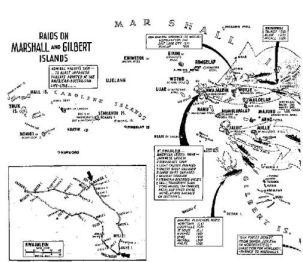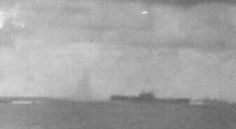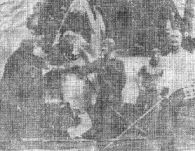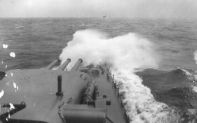Chapter 4
THE FIRST STRIKE BACK

After refueling and a briefing by Captain Zacharias on tomorrow’s, February 1st 1942, Marshal and Gilbert Islands Raid, the crew set about checking and fine-tuning all systems to make sure everything was ready for our first attack from the sea of the war on Japanese territory. Serious trouble with the Spot 1 Teledyne in the Foretop was discovered that evening but Chief Robert G. Haigler,  Ensign Lyle D. Ramsey,
Ensign Lyle D. Ramsey,

 Lt. “Deadeye” George O’Connell and crew worked all night rectifying the problem. Fortunately they were ready to commence firing on order in the morning.
Lt. “Deadeye” George O’Connell and crew worked all night rectifying the problem. Fortunately they were ready to commence firing on order in the morning.
Seven island targets were hit simultaneously by two Task Forces, the Yorktown and the Enterprise operating separately in a time-coordinated attack. This mission was characterized as like sailing up the muzzle of a gun pointed at the American-Australian lifeline and blast that threat away. Our orders were to block the enemy’s harbors with the wreckage of enemy’s ships, destroy their aircraft, render useless their airfields, destroy their radio installations, fuel storage tanks and storehouses
The seven island targets were divided between the two carrier groups. The Carrier Yorktown attacked Jaluit, Mili and Makin. The Enterprise Task Force attacked Roi, Kwajalein, Wotje and Taroa islands. All were bombed from the air and in addition, due to their heavy installations Taroa and Wotje were bombarded from the sea. Cruiser Division 5 was given the mission to handle the attack from the sea. The Chester along with the destroyers Maury and Balch handled the destruction of Toroa. The Salt Lake City and Northampton along with the destroyer Dunlap obliterated the most fully developed and heavily fortified Wotje Island.
The Task Force cruised at high speed into the night to be in position to start the coordinated attack 15 minutes before daylight. The destroyer Dunlap, cruisers Salt Lake City and Northampton left the Enterprise during the night and early in the morning hours reduced our speed so we wouldn’t arrive at our target early. Reveille was at 0330 HRS with a hardy breakfast of steak and eggs, which became the norm on the day of combat action. The crew was at battle stations quarters one hour before daylight.
The Salt Lake City and the Northampton launched spotter planes to scout the area 40 minutes before sunrise. The thundering explosion of the catapults’ propelling charges awoke unexpected life in the darkness ahead. A bright red rocket from a previously unseen Japanese patrol boat suddenly arched into the sky in an attempt to give warning to those on shore. Luckily the patrol boat turned all their efforts to getting home fast away from those black-bulky mysterious objects that startled them. The destroyer Dunlap went after them in hot pursuit but the low profile fast little boat was a difficult target in the darkness. We went on about our business while the Dunlap concentrated on the patrol boat.
As it became daylight about six fighter planes from the Enterprise attacked and the islands anti aircraft fire quickly marked its location; unfortunately one of our fighter planes strafing at a very low-level altitude was shot down. This was quickly followed by columns of black smoke rising from a silhouette of the island off the starboard bow. However it was soon learned the columns of black smoke were not bomb hits but ships firing up their boilers to make a run for it. The initial report from our spotter planes indicated no shore batteries could be seen and three ships were in the harbor. This was soon corrected as well camouflaged shore batteries opened up on us with shells coming dangerously close putting a nice round hole in our forward smoke stack and the Northampton was straddled by a salvo. We quickly pulled back out of their range, as the aerial spotters couldn’t locate their well-camouflaged position until after sun up when their telltale shadows gave them away. Also after sun up the Dunlap was able to get the low profile patrol boat squarely in her sights and blast her out of the water just as it was going into the harbor entrance.
All of the Enterprise bombers were attacking other island targets as only fighters were used on Wotje to strafe and distract the enemy’s attention to the air while the surface ships got into position to do the real business of demolition. Some Japanese planes got into the air before we laid several eight inch salvos down the concrete runway and spoiled their day from trying to make any more takeoffs or landings. Four of the Japanese planes that did get into the air were quickly shot down and our fighters returned to the Enterprise to reload for another mission.
We switched to armor piercing shells to go after the convoy trying to hide in the harbor. The Japanese vessels were armed merchantmen or auxiliaries and they tried in vain to hit us with their deck guns. The Salt Lake City laid one 10-gun salvo along side of a big auxiliary ship with its deck gun firing at us but her shells were landing short. Our next 10-gun salvo ripped into the Japanese ship: it looked like the smoke stack and the whole center section just lifted up above the rest of the ship and it sank fast with the gun on the fantail still blazing away.
Thus, not only did the Salt lake City fire the first shells to land on Japanese soil, but also sank by surface ship gunfire the first enemy ship of the war. We also rendered useless for the rest of the war the airfield at Wotje Atoll in the Marshall Islands.
For about two hours we cruised back and forth past Wotje firing nearly 30,000 yards over the island at ships in the lagoon to about 10,000 yards knocking out shore batteries before given the order to withdraw. The Northampton, Salt Lake City and Dunlop left to join up with the Enterprise and three destroyers leaving behind a patrol boat and nine enemy ships sunk, one beached, one damaged and dead in the water. On the island all barracks, shops, warehouses, fuel oil storage tanks, aviation gasoline dump, shops and two hangars were destroyed. All the coastal defense batteries silenced. Later in the day the attacking Enterprise aircraft assigned to cleanup found nothing to mop up.
Shortly after we rejoined the rest of the Task Force, Japanese bombers from other islands began attacking with vengeance. Our anti-aircraft crews put up a curtain of fire at the attackers as the ships zigzagged to avoid the falling bombs. If you looked up at them it looked like the bombs were going to hit you between the eyes with the closest one landing less than 100 yards away. However, none of the ships were hit, but we did find shrapnel from near misses around our gun shield and some minor damage on other parts of the ship.
|



